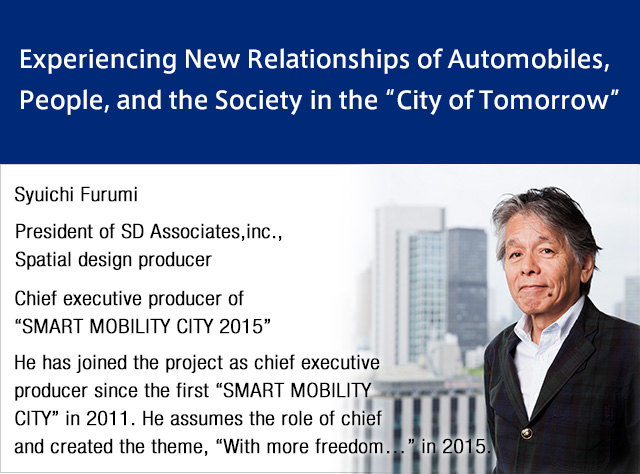- JAPANESE
- ENGLISH

category:Official Information
2015.07.01

――:What are the objectives of the theme, "With more freedom..." for SMART MOBILITY CITY 2015?
Furumi: Automobiles have two types of existential values. One is "to provide freedom in transportation," and the other is "to be the greatest invention in the twentieth century and a partner to humans." We sometimes call a car "a beloved vehicle," but you would probably agree that there are only few tools to which we attach a word "beloved." In other words, automobiles themselves hold a position very close and intimate to lives of humans. Such new usage of automobiles has been arising with the advancement of ICT (information and communications technology), energies, and cities.
For example, until recent years the transportation by a vehicle used to mean only a simple movement from point A to point B. But now with ICT providing information, the range of options for pleasure has expanded, such as, "Oh, what are we going to eat at point B?" In addition, ICT improves the level of safety and leads to a more environment-friendly lifestyle by promoting efficient driving. When further advancements are made to ICT to enable automated driving, even those with physical difficulties and the elderly will be able to enjoy traveling in the same way as able-bodied people do. That is one of "freedoms" as well.
――:Japanese high technology is what lies behind the generation of various "freedoms," isn't it?
Furumi: Yes, it is. Without question, Japan is leading in automobile designs and technologies but is also in the front line of ICT, materials, and manufacturing technologies. I imagine that Japan is the first country that can propose new relationships of automobiles and the society ahead of the rest of the world. Originally, that was the idea of SMART MOBILITY CITY. In a sense, it was inevitable that the project came into being within the "Tokyo Motor Show." We can safely say that this has been inspired only because he motor show is held in a rare nation where there is an accumulation of advanced technologies, from automotive to ICT and so on.
Thus, not only have we invited automotive manufacturers, but companies and entities stemming from multitude of fields that are in connection with automobiles in showcasing their technologies, which I think is an one and only endeavor, and making it unique in the world.
――:To which parts would you like the visitors to pay attention?
Furumi: It is hard to convey the significance of technologies by just their appearances. This is the reason why we decided to create the "City of Tomorrow" this time. In this city, we would like visitors to see and feel the vehicles of tomorrow. Furthermore, the SMART MOBILE CITY is a fictional town, yet it contains reality in some parts. For example, visitors can ride an actual vehicle. Through such experiences, they will be able to understand the answers to questions like"What is automated driving?" and "How will personal mobility advance in the future?" It is also one of the appeals of the town that it visualizes the background and outline of technologies.
――:What are the characteristics of the year 2015 version of SMART MOBILE CITY that are different from the past ones?
Furumi: Tokyo will change significantly for the 2020 Olympics Games. By then, a glimpse of a hydrogen society will be visible, and automated driving should be in operation to a limited extent. In consideration of this scenario, we can say that the "City of Tomorrow" of SMART MOBILITY CITY in 2015 will be showcasing the scenes of the year 2020 ahead of time. Moreover, in this city, visitors will witness new relationships of automobiles, a city, and people's life of the further future after 2020 as well. The city will present realistic forms that will soon be within our reach. When visitors see them, I would be delighted if they feel our excitement and ambition: "Let's surprise the world!"